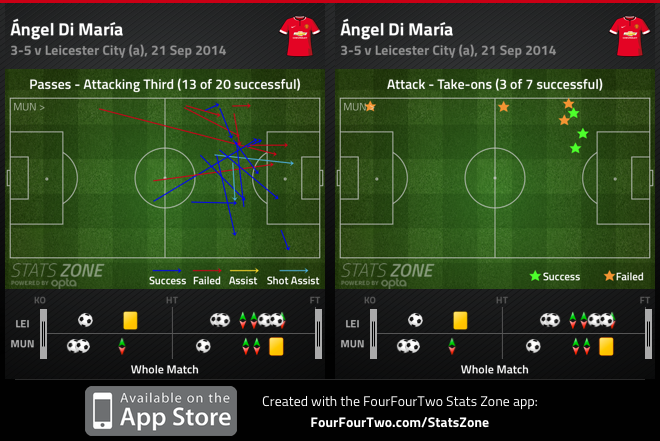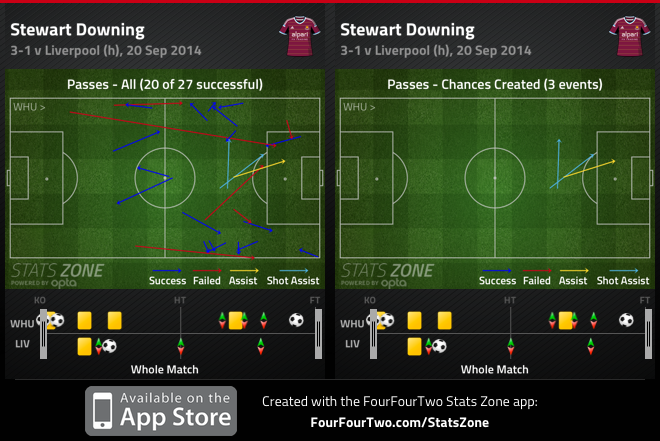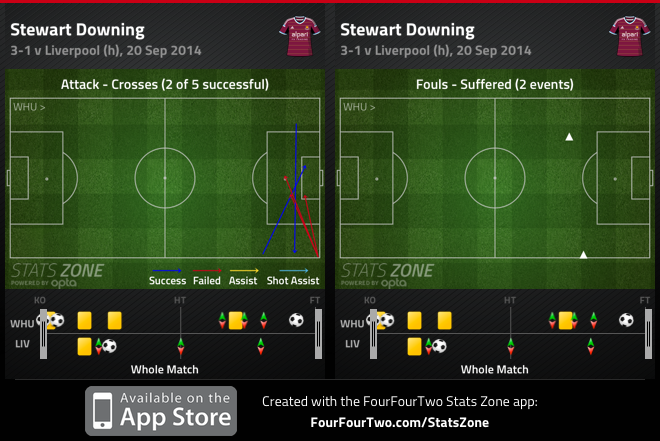What Premier League stars can learn from Stewart Downing in a midfield diamond
With the recent Premier League tactical shift towards diamond midfields, Michael Cox explains how West Ham wide-man Stewart Downing has adapted in style...

Last weekend underlined an interesting tactical shift in English football – the Premier League has suddenly become obsessed with a midfield diamond.
Two of the weekend’s four televised games told the story. On Saturday evening, West Ham shocked Liverpool by matching their diamond in the centre of the pitch, and exposing their two centre-backs with direct play towards the two strikers. West Ham could have won by a greater margin than 3-1.
Early on Sunday afternoon, Leicester pulled off a similar trick against Manchester United.
With Louis van Gaal’s side playing a midfield diamond, Nigel Pearson bravely played three forwards, with David Nugent instructed to drop deep and mark Daley Blind. Leicester’s front three caused real problems, and they ran out deserved 5-3 winners.
These are just two examples, but this represents something significant. The midfield diamond is barely ever witnessed in English football, with teams generally favouring formations involving width – 4-4-2, 4-3-3, 4-2-3-1.
Formations featuring three at the back have crept back into the game, but the diamond is something different entirely. It’s difficult to remember a top Premier League side consistently using the diamond since the early days of Carlo Ancelotti’s Chelsea side – now both Liverpool and Manchester United are doing so, and opponents are seeking to match them.
Wide boys
Get FourFourTwo Newsletter
The best features, fun and footballing quizzes, straight to your inbox every week.
English football is traditionally all about width – get the ball wide, and stick crosses into the box. The diamond, of course, is all about narrowness, about packing men into the centre of the pitch.
The ‘shuttlers’ on the outside of the diamond are able to drift out towards the flanks, but their starting position is always narrow, as part of a midfield three.
So the question is obvious: where, exactly, do wingers belong in a diamond formation?
Last weekend offered two different solutions. Manchester United’s Angel Di Maria proved wingers are capable of doing a job in a more central position – he was again magnificent at Leicester despite the eventual defeat, scoring with a tremendous scooped finish to put United 2-0 ahead. The passes he played into the final third were generally from central positions, but he drifted wide to attempt dribbles from the left touchline too.

Di Maria, though, is a curious player. He’s not really a winger, but not a central midfielder either, and in truth he’s more suited to a diamond than any other formation.
That was the shape he became accustomed to at Benfica, and in roles at Real Madrid and Argentina, often found himself playing in a vaguely similar, unusual position. Classic wingers don’t have Di Maria’s energy, tenacity or defensive discipline, and would find it difficult to adjust to the narrow positioning involved.
A more interesting solution came the previous evening in West Ham’s game against Liverpool – and, somewhat surprisingly, not from Raheem Sterling. We know all about Sterling’s adaptability, and that he thrives at the top of a diamond where he can exploit space created by the two strikers, and drift to both flanks. However, the outstanding performer was his opposite number – ex-Liverpool winger Stewart Downing.
Downing the Reds
The curious thing about West Ham’s performance was that they continued to play with tremendous width, in keeping with the approach Sam Allardyce has encouraged over the past few years, despite the narrow format of the side. This was partly because Diafra Sakho and Enner Valencia drifted wide dangerously before turning up at the far post to provide an aerial target, and partly because Downing cleverly drifted wide despite theoretically playing a central role.
Downing’s performance was particularly impressive because he also man-marked Steven Gerrard, with his energetic and disciplined defensive performance ensuring Liverpool’s skipper struggled to impose his passing on the contest. Downing brought the defensive ability he’d learned out wide by tracking dangerous full-backs – perhaps similar to the way Park Ji-Sung once nullified Andrea Pirlo, the player Gerrard is trying to be.
Downing’s attacking contribution, though, was even more useful. With West Ham generally playing on the counter-attack, Downing could surge up and down the pitch vertically, rather than having to drift laterally to find small pockets of space, which requires more intelligence.
He might have been in an unfamiliar position, but Downing wasn’t entirely out of his comfort zone. He created three chances, all from open play, including an assist for Morgan Amalfitano’s late clinching goal.

But interestingly, Downing also sent in two dangerous crosses from open play – one from either side – and won two free-kicks near the flanks too.

Just because he started centrally, it didn’t mean he needed to stay there. That, in a nutshell, is what the central winger is all about, and with the diamond becoming the latest trend in English football, others might look to Downing for inspiration.
